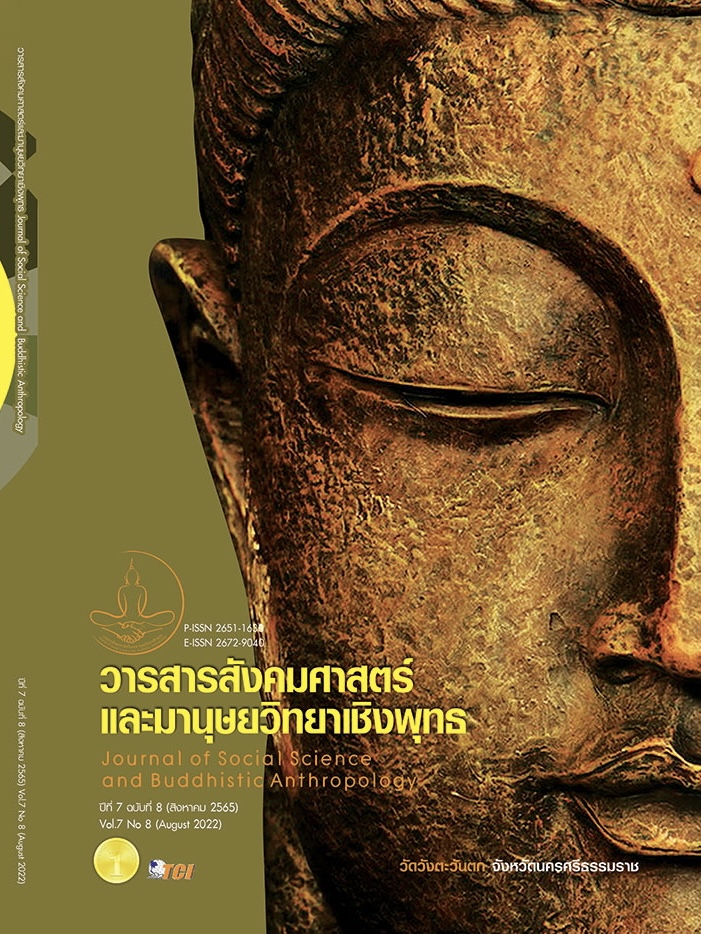SYNTACTIC AND SEMANTIC PROPERTY OF EPISTEMIC MODALITY “khɨ:siʔ” IN NORTHEASTERN THAI DIALECT
Keywords:
Syntax, Epistemic Modality, Northeastern Thai DialectAbstract
The objective of this article was to analyze syntactic and semantic properties of epistemic modality called “khɨ:siʔ” in northeastern Thai dialect which conveys diverse meanings of epistemic modality. This study was a qualitative research complied northeastern Thai dialect data from documents, folk story tales, online databases and northeastern Thai dialect used in daily life from Dramas and Films. The result in term of syntactic property found that epistemic modality “khɨ:siʔ” referred to specified meaning of epistemic modality is obligately appeared in 3 the positions and constructive units ; 1) noun phrase + epistemic modality + verb phrase + particle 2) noun phrase + epistemic modality + verb phrase + noun phrase and 3) constructive unit found is temporal word + epistemic modality + verb phrase. Semantically, it found that epistemic modality “khɨ:siʔ” performs its meaning according to the framework of epistemic modality. It represents speaker’s inference whose sentences are uttered and found 3 minor meanings; 1) possibility which is a speaker’s possible inference, 2) probability which is highly inferred that the proposition is true, and 3) inferred certainty which identifies that speaker has rational reason to believe the proposition is true as well.
References
การ์ตูนหนูหิ่นอินเตอร์. (2562). หนูหิ่นอินเตอร์. เรียกใช้เมื่อ 4 มกราคม 2565 จาก https://www.mebmarket.com/index
คำจุ๊เดอะซิทคอม. (2563). ซีรีส์คำจุ๊เดอะซิทคอม. เรียกใช้เมื่อ 5 กุมภาพันธ์ 2565 จาก https://www.youtube.com/watch?v=0ANLVZAAKNs
คำพูน บุญทวี. (2538). ลูกอีสาน. กรุงเทพมหานคร: บรรณกิจเทรดดิ้ง.
ธนานันท์ ตรงดี. (2553). ไวยากรณ์ภาษาไทยถิ่นอีสาน. ในการประชุมวิชาการโครงการไวยากรณ์ไทยฉบับครอบคลุมภาษาย่อย เรื่อง ความหลากหลายของภาษาในสังคมไทย ภาษาไทยมาตรฐาน ภาษาไทยถิ่น และภาษาย่อยในสังคมไทย : ประเด็นปัญหาและข้อค้นพบใหม่. กรุงเทพมหานคร: เอเอสพี.
ธนานันท์ ตรงดี. (2557). ภาษาไทยถิ่นอีสาน. ในการประชุมวิชาการโครงการไวยากรณ์ไทยฉบับครอบคลุมภาษาย่อย เรื่อง ความหลากหลายของภาษาในสังคมไทย ภาษาไทยมาตรฐาน ภาษาไทยถิ่น และภาษาย่อยในสังคมไทย : ฉบับไวยากรณ์ไทยถิ่นอีสาน. กรุงเทพมหานคร: เอเอสพี.
นววรรณ พันธุเมธา. (2527). ไวยากรณ์ไทย. กรุงเทพมหานคร: รุ่งเรืองสาส์นการพิมพ์.
พิมพ์ญา. (2558). ฮัก ณ อีสาน. กรุงเทพมหานคร: พิมพ์ญาบุ๊ค.
ภาพยนตร์ไทบ้านเดอะซีรีส์. (2560). ไทบ้านเดอะซีรีส์. เรียกใช้เมื่อ 2 มกราคม 2565 จาก https://movie.trueid.net/th-th/movie/Yxp6qyORM9ao
รายการบ่าวบุญมา. (2564). Youtube chanel บ่าวบุญมา. เรียกใช้เมื่อ 4 มีนาคม 2565 จาก https://www.youtube.com/watch?v=-ZuJaQqgJRA
ละครนาคี. (2560). ละครโทรทัศน์เรื่องนาคี. เรียกใช้เมื่อ 1 กุมภาพันธ์ 2565 จาก https://ch3plus.com/v/56072
ส้มภัคเสี้ยน. (2560). ภาพยนตร์ส้มภัคเสี้ยน. เรียกใช้เมื่อ 20 มกราคม 2565 จาก https://www.youtube.com/c/MajorGroup
สุดา รังกุพันธุ์. (2547). กริยารองไปและมาในภาษาไทย. ใน
วิทยานิพนธ์อักษรศาสตรมหาบัณฑิต ภาควิชาภาษาศาสตร์. จุฬาลงกรณ์มหาวิทยาลัย.
เฮาฮักภาษาอีสาน. (2562). เพจเฮาฮักภาษาอีสาน. เรียกใช้เมื่อ 3 มีนาคม 2565 จาก https://www.facebook.com/HaohugpasaEsan
Bybee, J. at al. (1995). The Evolution of Grammar: Tense, Aspect, and Modality in the Language of the world. Caribridge: Chicago and London: The University of Chicago Fress.
Eed Ponglang. (2564). Eed Ponglang. Retrieved มกราคม 30 , 2565, from https://www.youtube.com/results?search_query=eed+ponglang
Radden, D. at al. (2007). Modality. Amsterdam-Philadelphia: John Benjamins Publishing.
Van Valin, R. D., Jr. & Lapolla, R. J. (1997). Syntax: Structure, Meaning and Function. Cambridge: Cambridge University Press.
Downloads
Published
How to Cite
Issue
Section
License
Copyright (c) 2022 Journal of Social Science and Buddhistic Anthropology

This work is licensed under a Creative Commons Attribution-NonCommercial-NoDerivatives 4.0 International License.








